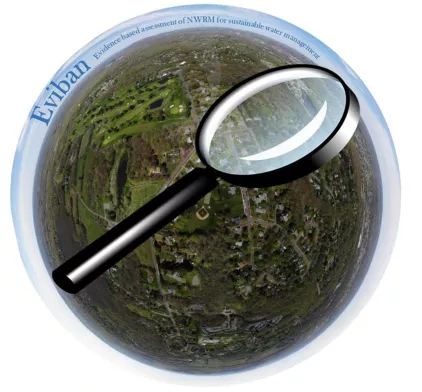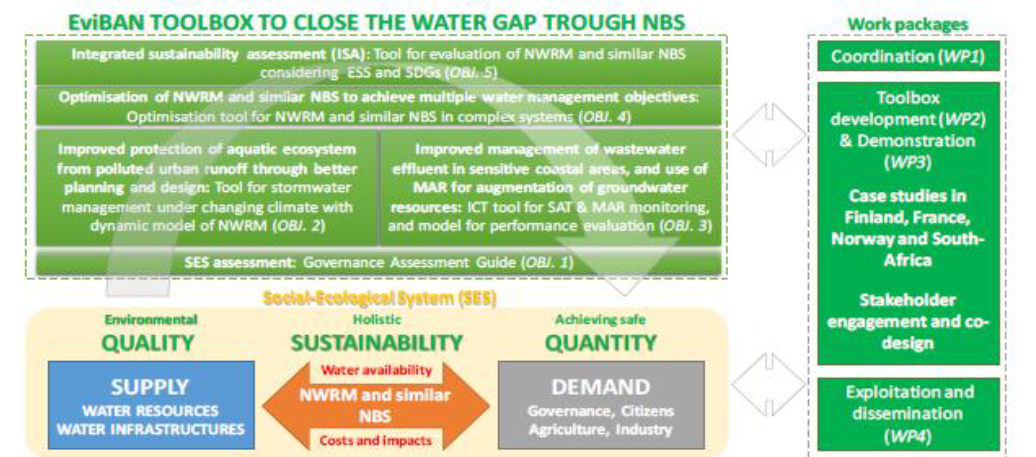EVIBAN
Evidence based assessment of NWRM for sustainable water management

Partners
Partners
Stellenbosch University Water Institute
VTT Technical Research Centre of Finland Ltd
Aalto University School of Engineering
BRGM
IMAGEAU
GeoHYD
Abstract
Abstract
EviBAN will increase the knowledge on evidence based, sustainable management of water resources. This will be achieved by developing a toolbox for evaluation of adaptive management options and measures that account for impacts of climate change, anthropogenic activities and societal change in different regions of Europe and beyond. The toolbox will have a Governance Assessment Guide; a tool for stormwater management under changing climate with dynamic modelling of NWRM; an ICT tool for SAT & MAR monitoring, and model for performance evaluation; an optimisation tool for NWRM and similar NBS in complex systems; and an integrated sustainability assessment (ISA) including evaluation of ecosystem services (ESS). Optimisation will be based on performance and cost. Measures acting on water quantity and/or quality will be evaluated. Management options will be evaluated by ISA to assess their ability to mitigate negative impacts of human activities and climate change on the water cycle, and contribute towards the UN sustainable development goals (SDGs). The project activities will be performed by a multidisciplinary team with researchers, water service providers, public agencies for water and health, and private companies supplying NBS and ICT (Information, Communication Technology) monitoring solutions. The toolbox will be developed, tested and verified using data from case studies from Finland, Norway, France and South Africa to cover diverse conditions with respect to climate, water resources, hydrogeological conditions and water management challenges. EviBAN will thereby enable evaluation of adaptive management options and measures that account for impacts of climate change, anthropogenic activities and societal change in different regions of Europe and beyond.
Project Structure
Project Structure
The activities will be organised in work packages (WPs) for: Coordination (WP1); Toolbox development (WP2); Demonstration (WP3); and Exploitation and dissemination (WP4) as outlined in Figure 2 above. Execution of the activities will be the responsibility of the principal investigators from the collaborating partners: BRGM, ImaGeau, and Géo-Hyd (FR); Stellenbosch University (SA); VTT and AALTO (FIN); and SINTEF (NO). While SINTEF will be the coordinator of the project, work in the WPs will be a joint and integrated effort utilising the complementary competences of the partners. The case study stakeholders will be important dialogue partners and provide access to important data and sites for fieldwork.

WP1 will provide the arenas for coordination of activities between the partners, organise project-wide meetings and workshops, facilitate project-wide involvement of stakeholders, and perform formal monitoring and reporting from the project to the FPOs.
WP2 will develop the toolbox for evaluating NWRM and similar NBS using a SES approach and is organised with tasks for each of the tools in the toolbox outlined in the figure above. WP3 will demonstrate the applications of the WP2 toolbox methods in the case studies.
WP3 will collect the supporting data from the study sites and prepare site maps, environmental datasets, and climate change summaries for dissemination in WP4. The joint goal is to integrate the case study results through applications of optimisation in the selected most suited case studies, and through the ISA exercises in all case studies.
WP4 will promote the innovation developed during EviBAN by companies in collaboration with scientific institutions, stakeholders and policy makers for the development of the adaptive water management toolbox as outlined in section 2.3. WP4 will inform about project life, results of the project and make results available for use.
Outcomes and expected impact:
Outcomes and expected impact:
EviBAN will produce outputs to the scientific community, to water managers and policy, and the public. A main output for the scientific community and water managers will be the toolbox with the different tools that will be developed in WP2 and be available on the project website after the project has been completed. The tools will be in the form of software models, spreadsheet templates and written guidelines as appropriate for the different uses. Some components will be based on existing models distributed by others under open source e.g. SWMM or with restrictions e.g.MARTHE model owned by BRGMwith license fees. In such cases the toolbox will provide reference to where the software can be obtained and guidance for use in contexts covered by EviBAN. The toolbox components are expected to be used primarily by the scientific community and advanced water management users. Further outputs to facilitate uptake of the results will be four reports covering the framework and KPIs for the learning alliance and three project/international workshops on: i) Drivers and barriers to NBS, ii) Toolbox development, needs and ambitions, iii) Potential of the EviBAN NBS to 'closing the water gap'. Training sessions on hydrogeological and hydrogeochemical modelling will be organised for local stakeholders in the cases studies with MAR. EviBAN outputs will also include case study results from: Demonstrations of NWRM for stormwater management and evaluation of MAR for peak stormwater runoff to cope with drought-stress, including optimization of the solutions; performance and optimisation of SAT for treated wastewater and dissemination of ICT solution. A main integrating output for all cases will be the ISA assessment methodology and demonstration of its applicability through different water management case studies. These outputs will come in the form of a main results report and a policy brief for each of the case studies that will be aimed at water managers and policy makers, respectively. Further, manuscripts for five scientific papers are planned to address the four case studies and the developed toolbox. Outputs aimed at the public include digital content on the project webpages and in social media about the demonstration sites, dissemination events and information from the stakeholder workshops. EviBAN will develop new knowledge on how NBS should be used under different conditions to contribute to progress towards SDGs and transfer the knowledge into innovative tools for adaptive water management. In the short term, the case studies with strong commitment of end users and stakeholders will bring direct outcomes aligned with the WJPI SRIA – Theme 5, and the expected impacts in the H2020 Societal Challenge 5, Call topic SC5-33-2016. Enhancing innovation capacity and integration of new knowledge will be ensured by the collaboration within EviBAN, which will be enriched by the strong multidisciplinary team (climate-science, water engineering, hydrogeology, ICT, water treatment, water network and quality), the noteworthy transnationality of the activities. This will ensure impacts such as the improved use of […] resources in the area of water research and innovation, an improved synergy […] between national and EU funding, […] exchange of good practices; strengthened international leadership of European research in this area, and implementation of the objectives of the JPI on Water. The knowledge will be operationalised through the toolbox, so end-users and potential clients can benefit from all the synergies between the functionalities developed. This will give more sustainable water management by utilising recommendations for the inclusion of climate and stormwater model parameters in local standards for NBS design, facilitating use of NBS as a sustainable means of reducing diffuse water pollution, evaluating optimal implementation of NBS with different water sources in terms of resulting water quality and economic cost, performing ISA on MAR strategies as management options, and improving stakeholder involvement through use of ICT-tools. In the intermediate term, the toolbox will support achievement of the UN SDGs, strengthen the competitiveness and growth of companies, and support the development of technological solutions and services for the implementation of EU water policy. The tools developed in EviBAN are responding to urgent needs to close the water gap in different socio-economic and climatic areas. These needs are expected to increase dramatically in the future, and are strong drivers for worldwide implementation of the solutions developed by the project´s companies, thus contributing particularly to SDG 6 'Ensure availability and sustainable management of water and sanitation for all', SDG 13 'Take urgent action to combat climate change and its impacts', and the development of 'innovations meeting the needs of European and global markets'. Also, these tools promote a sustainable way to reach a good environmental quality and to provide safe and sufficient water for the different uses, thus supporting directly the implementation of EU water policy. The long-term impact will be achieved through the exploitation of the results and the commercialisation of the tools by the collaborating companies. This will improve the management of stormwater, wastewater, groundwater and alternative sources, and develop new approaches toward a better water system sustainability, resilience and satisfaction of water users. As such, EviBAN will directly contribute to the implementation of various EU Regulations & Policies, in particular the Water Framework Directive; Groundwater Directive; Floods Directive; Water Scarcity & Drought Strategy and the Roadmap to a Resource Efficient Europe.